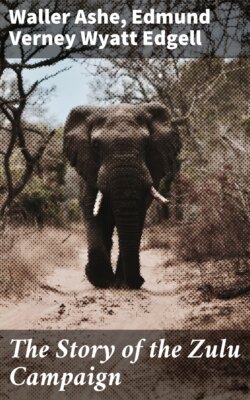Читать книгу The Story of the Zulu Campaign - Edmund Verney Wyatt Edgell - Страница 11
На сайте Литреса книга снята с продажи.
No. 3 Column (Headquarters, Utrecht).
ОглавлениеCommandant—Colonel Evelyn Wood, V.C., C.B., 90th Regiment.
Royal Artillery—11th battery 7th brigade R.A. (with four 7-pounder guns) under Major E. Tremlett, R.A.
Infantry—1st battalion 13th Regiment and 90th Regiment.
Mounted Infantry—100 men, under Major J. C. Russell, 12th Lancers.
Frontier Light Horse—200 strong, under Major Redvers Buller, C.B., 60th Rifles.
Volunteers—The Kaffrarian Vanguard, Commandant Schermbrucker, 100 strong.
Native Contingent—The Swazis, our native allies, some 5000 strong.
An idea of the numbers and nature of Cetywayo's force may be gathered from the report of the Government Intelligence Department made at this time.
"The Zulu army, as at present constituted, is drawn from the entire male population, as every male between the ages of fifteen and sixty-five is called upon to serve, without any exemption. The military force consists of fourteen corps or regiments, divided into wings right and left, and the latter into companies. The companies, however, are not of equal strength, but vary immensely, even from ten to 200, according to the numerical strength of the corps to which they belong. In fact, the companies and regiments would more correctly be termed families or clans, and each corps possesses its own military headquarters, or kraal, with the following hierarchy, namely, one commanding officer, chief, or Iduna-Yesibaya; one second in command, major, or Iduna-Yohlangoti, who has charge of the left wing; two wing officers, and company officers according to the need of the battalion. As a rule, all these officers are in command of men of the same ages as themselves, and the method of recruiting is as follows:—At stated and periodical intervals, generally from two to five years, a general levy takes place, when all the youths who happen at that time to have attained the age of fifteen are formed into a regiment and undergo a year's probation, during which time they are supposed to pass from boyhood to manhood. As the regiment becomes disciplined and seasoned it receives large drafts from other corps, so that as the elders die out young men come in to fill up the ranks. The entire Zulu army consists of thirty-three regiments, married and unmarried. No one in Zululand, male or female, is allowed to marry without the king's permission, and this permission is never granted until the men are about forty years of age. They then have to shave the crown of the head, and to put a ring round it, and carry a white shield, in contradistinction to the unmarried regiments, who do not shave their heads and carry coloured shields. Many of these regiments are too young for active service, others are too old, consequently it is estimated that only about twenty-five regiments would be able to take the field, and these would muster perhaps 40,000. Of these 4500 are between fifty and sixty years of age; 3400 are between forty and fifty; 10,000 between thirty and forty; and 22,000 between twenty and thirty. We have heard a great deal about the drill of these, but their movements, as far as we can learn, are few and very simple, but very quickly performed in their own way. They form circles of regiments in order to outflank the enemy. From this formation they break into columns of regiments or companies, and from these into skirmishing order, with supports and reserves. The sole commissariat of the Zulu army consists of three or four days' grain, carried by the lads who follow each corps, and, if necessary, a herd of cattle driven with each column."
